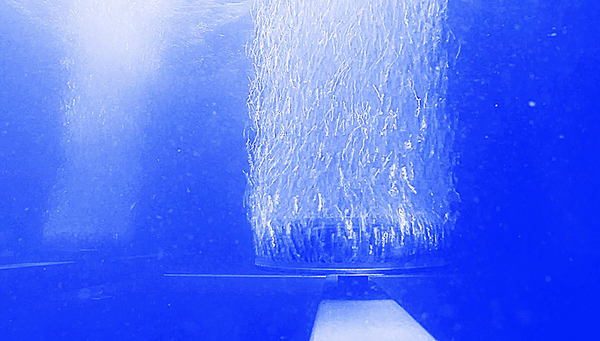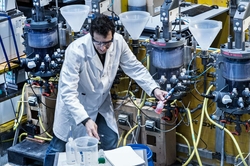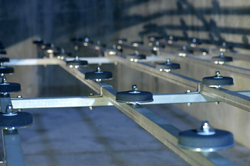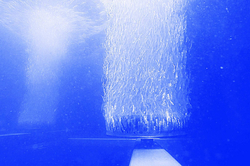News Detail
Eawag Info day 2015: 100 sewage treatment plants must be upgraded
September 3, 2015 |
Wastewater contains a multitude of micropollutants. These include hormones, cosmetics, medications and biocides. These substances contaminate our bodies of water, in spite of the high technological standards of the water treatment plants. One consequence of the new water protection law will be the requirement to install technological measures for removing micropollutants at larger plants and at those on especially heavily-used bodies of water. Around 100 of the 700 or so sewage treatment plants in Switzerland will be affected.
Eawag, the Swiss Federal Institute of Aquatic Science and Technology of the ETH Domain, was heavily involved in drafting the quality standards for Swiss waters and developing efficient technical measures for the sewage treatment plants. At this year’s Eawag Info day, held at the EPF in Lausanne, around 200 experts from the political, administrative, business and scientific fields provided an overview of the present situation in Switzerland and the latest research in the area of micropollutant elimination.
In the right direction
The tenor of the event was clear: the path being taken by Swiss politics is heading in the right direction, yet research must continue to be encouraged in parallel with this. “Switzerland will assume an international pioneer role in water protection when it adds additional purifying stages to eliminate micropollutants in selected sewage treatment plants”, stated Michael Schärer, head of the water body protection section of the Federal Office for the Environment. The result will be an increased level of protection of aquatic communities and drinking water resources.
In her presentation, Christa McArdell, head of Eawag’s Environmental Chemistry department, indicated the potential importance of striving for new advances in the field of analytics. For example, a recent Eawag study has shown that insecticides, in spite of a reduction in the quantities used, are far more prevalent in water bodies than today’s monitoring programmes show.
Research results in the present
Two processes for removing micropollutants from sewage have proved effective: ozoning and treatment with pulverised active charcoal. Various research projects are currently investigating whether the biological sewage treatment that is standard in sewage treatment plants today can be further optimised to improve micropollutant removal. Eawag researcher Adriano Joss, a member of the EU Athene research project, draws a sobering conclusion: “According to our present knowledge, there is still no biological process that can sufficiently eliminate micropollutants from sewage.” It is thus still the case that the biological stage in communal sewage treatment plants needs to be supplemented with an extra stage – ozoning or treatment with active charcoal – in order to reach stated targets. Joss: “The strategy that the federal government is pursuing is therefore correct.” Introduction of the so-called fourth treatment stage also represents an opportunity for Switzerland as an industrial and scientific location.
Recently, the combination of the two processes has started to be considered. Joss: “In some locations this can even lead to lower costs, if one adds in the operating expenses.” Such questions are now being addressed in research projects. Joss is working together with the ProRheno treatment plant (Basel City), among others, which is trying out a combination of both processes in a new pilot plant. For sites where only a reduced level of ozoning is possible, a combination process is one possible solution. He cited the recent research results of Urs von Gunten, who is carrying out research at Eawag and the EPFL into the elimination of micropollutants.
Ozone treatment is not appropriate for all sewage
“Ozoning is a process that functions very well in general”, said von Gunten. It makes sense, however, to take a closer look at some sites. In the case of especially heavily contaminated sewage, such as that from industry or trade, ecotoxicologically problematic oxidation by-products can be created in this process. Von Gunten: “If the water contains, for example, high concentrations of bromide, ozoning can sometimes produce too high a concentration of potentially carcinogenic bromates.” The environmental chemist and his team have developed a five-part test with which it can be judged whether ozone treatment is appropriate for sewage at a particular site. “The test provides the authorities with a tool to help in decision making when it comes to building sewage treatment plants”, says von Gunten.
Financing the Investments
The upgrading of the treatment plants is made possible by a sewage tax based on the polluter-pays principle, in effect until 2040. Every plant pays 9 francs per connected resident to the federal government. This tax finances 75 per cent of the required initial investment, totalling 1.2 billion francs. As soon as a plant is upgraded with the additional purification stage, it is exempted from the tax.
Philippe Vioget, head of the water quality, surface waters and sewage treatment sector of the environmental Directorate-General in Canton Vaud, highlights the challenges facing the treatment plants in his canton. In order to meet federal standards for eliminating micropollutants, the extension of 14 regional treatment plants to add nitrification to the biological stage is being discussed. In contrast to the additional treatment stage for micropollutants, this would not be financed by the federal government. Financial contributions from Canton Vaud are a vital factor in making this upgrade achievable for communities.
Pictures / Downlaod
Free use of the pictures only in connection with this media release, no archiving.
Adriano Joss in the Eawag laboratory in Dübendorf. As part of the present EU research project Athene, he has set up 12 sewage treatment plants in laboratory format and is testing whether and how the present biological stage in treatment plants can be optimised for reducing micropollutants.
(© Eawag, Aldo Todaro)




